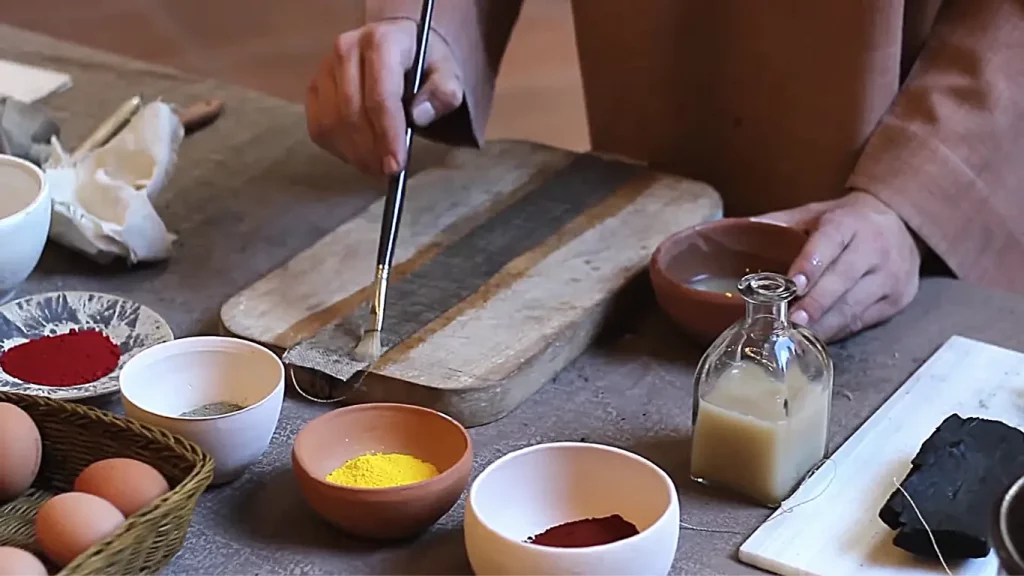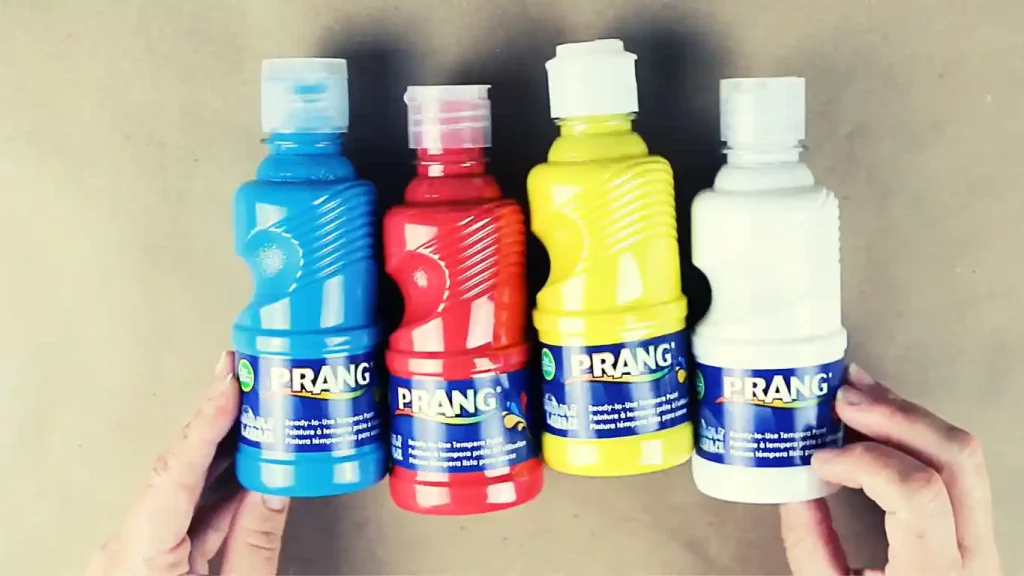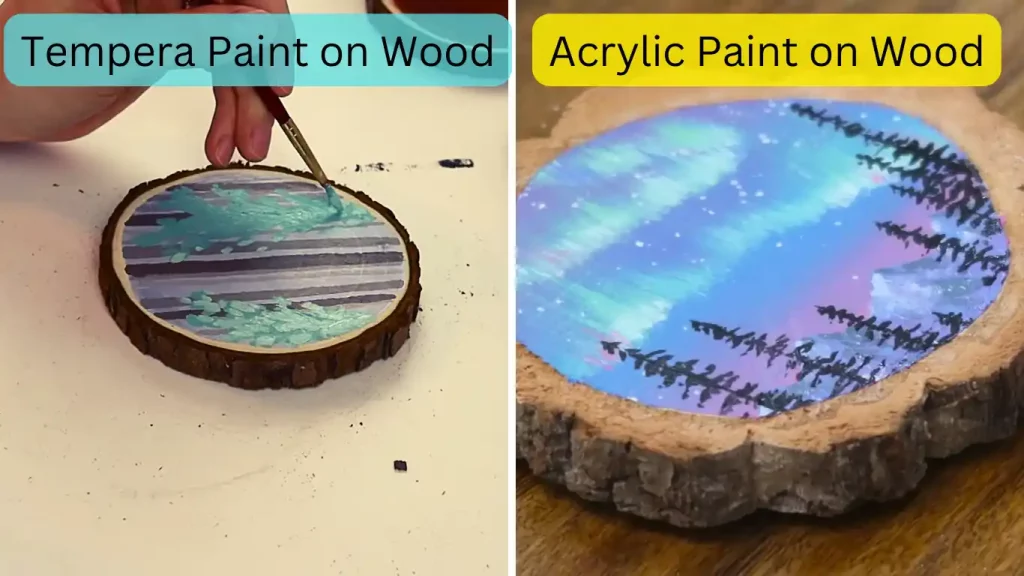Tempera paint is a water-based; non-toxic crafts paint mainly used for children’s art projects because it is washable and contains no toxic chemicals or allergens. You can use Tempera paint on various surfaces, including paper, canvas, posters, fabric, and even on glasses. So, Can you use Tempera paint on wood?
Yes, you can use Tempera paint on wood. However, you will need to sand the wood first to create a smooth surface for the paint to adhere to. Once the wood is sanded, you can apply a primer if you want, but it’s not necessary.

Can You Use Tempera Paint on Wood?
Tempera paint is well-known for its versatility. You can use Tempera paint on various surfaces as I mentioned earlier even on your hair if you like. You can use Tempera paint on wood for decorations. But is it for a permanent purpose? Then you should avoid using Tempera paint on wood. Because Tempera paint is not permanent and is likely to flake and chip on wood when it dries.
If your painted wooden surface remains indoors, tempera paint can last longer. However, you should avoid using tempera paint for outdoor wooden surfaces as it is not water resistant. Water exposure will peel the paint off the surface.
As you now know, when you can and can’t use Tempera paint, let’s see the preparation you need to apply the paint on wood.
How To Use Tempera Paint On Wood?
To use Tempera paint on wood, you must prepare the surface well. First, sand the surface to remove any little cracks or dirt. Sanding the wood will create a smooth surface for the paint to adhere better. Generally, tempera paint offers a matt finish but you can improve the shine if you want.
After sanding, you can use one coat of primer if you want. But priming the surface is not obligatory.
Then, simply paint your design onto the wood using tempera paint. Tempera paint dries quickly, so you’ll be able to add another layer of paint or varnish overtop once it’s dry.
If the wood is not adequately prepared, the paint will not adhere well and eventually peel off.
So, to paint your wood with tempera paint, follow these steps:
- Gather your materials
- You will need Tempera paint, a paintbrush, water, and wood
- Pour some Tempera paint into a bowl or container
- Add water to the paint until it is the desired consistency
- Dip your brush into the paint and apply it to the wood surface
- Continue painting until you are satisfied with the results
Allow the paint to dry completely before using or displaying the wood piece.

Sealing Tempera Paint on Wood
Sealing Tempera Paint on Wood, if you have ever used Tempera paint, you know that it can be tricky to work with. The paint is thinner and more watery than acrylic paint, so it tends to drip and run quickly.
This can make it difficult to get a nice, even coat of paint on your project. Another problem with tempera paint is that it doesn’t always adhere well to surfaces like wood. This can be a big problem if you are trying to seal the paint so that it will last longer.
So, how do you seal Tempera paint on wood? The best way to do this is with a clear sealer or varnish. You want to ensure that the sealer or varnish is compatible with Tempera paint before using it.
Once you have found a compatible product, apply it over the dried Tempera paint. You may need to apply multiple coats to get a good seal. Let each coat dry completely before applying the next one.
Once your final coat of sealer or varnish has dried, your project should be protected from wear and tear. The sealed tempera paint should also be resistant to fading from sunlight exposure.
Will Tempera Paint Wash off of Wood?
Yes, tempera paint washes off the wood. This paint is washable and non-permanent. After using it on the surface, you can easily wash it off. Water-based Tempera can easily be removed from the hard surface like wood with water. If you keep your Tempera-painted wood outside, water exposure will damage the paint and wash the paint off the surface.
But if you seal the paint and want to remove all stains and marks, you may need to use a little elbow grease to get it all off. If the paint is still wet, you can simply wipe it away with a damp cloth.
If the paint is dry, you can use a slightly dampened sponge or brush to scrub it away.

Why Was Tempera Paint Used on Wood?
Tempera paint was used on wood during the early Renaissance because it is a fast-drying, water-soluble paint. This paint dries quickly, making it ideal for large surfaces. And it is less likely to crack than oil-based paints.
Another reason is that tempera paint offers a very matt finish which helps to camouflage any imperfections in the wood. Tempera paint was also used because it could be applied in thin layers, allowing the artist to build up color slowly.
Do Tempera Paint Sticks Work on Wood?
Yes, tempera paint sticks will work on wood. However, the results may not be as intense as you would like them to be. In addition, the paint stick will act more like a crayon on wood, so if you are looking for bold and bright colors, you may want to try another type of paint.
How Long Does Tempera Paint Take to Dry On Wood?
Tempera paints usually take 5-10 minutes dry to touch. However, the drying time depends on the weather, humidity, thickness of the paint, and absorbency of the painting surface. When the water from the paint evaporates, the paint dries, and also air circulation plays a role in the drying process.
The main advantage of tempera paint is that it dries very fast. So, you can apply a second coat within a very short period of time. For example, after using the first coat, you can apply the second coat within 20 minutes or so. However, make sure to check if the paint is dry enough to apply the second coat.
The fast-drying nature of tempera paint can also be a disadvantage for you. If you make a mistake when applying the paint, you won’t have enough time to compensate.
What is Tempera Paint Used For?
Tempera paint is a type of water-based paint that has been around for centuries. It is made by mixing a dry powder pigment with a binding agent, typically egg yolk, and then adding water. The resulting mixture can be used to create vibrant, long-lasting paintings on nearly any surface.
One of the benefits of tempera paint is that it dries quickly, which makes it ideal for use in classrooms or other settings where time is limited. Additionally, it does not require using toxic solvents like oil-based paints, making it safer for both artists and their surroundings. And because tempera paintings can last for hundreds of years without fading or yellowing, they are often treasured as family heirlooms or historical records.
Whether you want to create a masterpiece or explore your creativity, tempera paint should definitely be on your list of supplies!
Is Tempera Or Acrylic Better for Wood?
There is no definitive answer to this question as it depends on the specific project you are working on and what your personal preferences are. However, we will provide a brief overview of tempera and acrylic paint so that you can make an informed decision about which one is better for your project.
Tempera paint is a water-based paint that has been used for centuries. It is known for its durability and vibrant colors. However, it can be challenging to work with because it dries quickly and can be tricky to blend.
Acrylic paint is a synthetic polymer resin made from petroleum. It was first developed in the 1930s and became widely used in the 1950s. Acrylic paint is easy to work with, doesn’t dry as quickly as Tempera, and can be mixed with other mediums, such as gel or paste, to create different effects.

The Bottom Line
Now you know that you can use Tempera paint on wood, but it’s not the best option. Tempera paint is water-based, so it will soak into the wood and won’t give you a very smooth finish. It’s also not as durable as other types of paint, so it’s more likely to chip or scratch off.
If you’re looking for a durable, long-lasting paint job, then Tempera isn’t the best choice. But for wood that you are going to set inside, you can use tempera paint to create beautiful designs.

S. Pushon is a paint expert, self-taught artist, and currently working as an adviser in the paint industry as a Quality Improvement and Development Assistant.
An artist by heart, he draws remarkable art pieces and as a professional paint industry individual, he seeks the insight and shares with enthusiasts. Read more…
